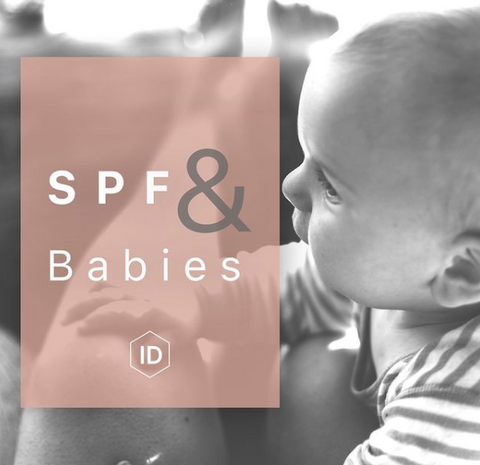SPF & Babies

We are regularly asked to advise on SPF for babies and young children and thought we would share our recommendations here.
If you're heading outside with your baby during this glorious weather, protecting your little one from the sun’s bright rays is extra important because newborn skin (epidermis) is 20-30% thinner, meaning it is extra susceptible to serious burns but also absorbs skincare products more easily. Therefore sunscreen is not recommended for babies younger than 6 months.
Babies under six months of age should be physically protected from the sun. The best thing to do is to keep them cool, hydrated, in the shade and out of the direct sunlight. Make sure they are wearing a hat and light, loose sun-protective clothing. As a good rule of thumb, only the hands and feet should be left uncovered.
It is best to avoid exposing newborn/young children’s skin to direct sunlight the 3 hours either side of solar noon (midday). This is when UVB is at its strongest and most likely to cause damage to the skin. It’s best to seek shade during this time or if out walking etc. have a newborn in minimal light clothing with a breathable UV protective film over their pram/buggy.
.
For babies over six months, you can use a broadspectrum UVA/UVB protective baby-safe SPF however clothing is still preferable to protect the skin, especially if your little one has sensitive, eczema-prone skin.
.
You can perform a home patch test and apply a small amount of the SPF on your baby 48 hours before using it to check for potential irritation. Again, because baby skin is thinner it is more sensitive, therefore more more likely to react to new products and may develop a rash. If this happens, talk to your GP.
For babies and children over six months, we recommend mineral sunscreens — ones containing physical sun-blockers such as zinc oxide or titanium dioxide — because we know they offer the broadest protection against UVA and UVB rays and tend to be less irritating to the skin. We only recommend mineral sunscreens to our adult patients too!
A rash vest or UV protective swimwear is ideal as it covers almost the whole body therefore children only need SPF on the face, neck, hands and feet – makes life a lot simpler than having to chase a wriggling toddler to apply SPF regularly to the entire body!
.
Thankfully, most sunscreens formulated for babies and children are mineral sunscreens. A mineral sunscreen sits on top of your skin acting like a shield and deflects UV rays away from your skin, while chemical sunscreens penetrate your skin and offer protection by dissipating UV rays by acting like a sponge.
.
In terms of application, be extra cautious around your baby or child’s face. For squirmy little ones, wait until they are calmer before applying. If sunscreen does get in their eyes, wipe them gently using a clean, damp cloth. Make sure to reapply sunscreen every two hours, or right after a towel drying the skin following a swim. This constant reapplication is as important as the first application!
.
In terms of the best SPFs for babies and children we would recommend: @eltamdskincare Sport (which we stock at ID, link in bio to our online shop) or @larocheposay Antehelios Dermo-Kids SPF 50+.